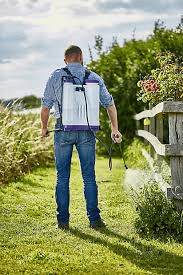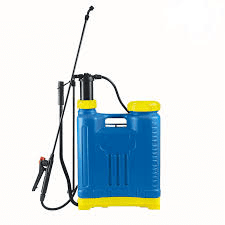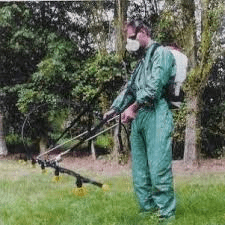Calibrating a knapsack or compression sprayer is a simple task which takes little time. A sprayer with a pressure gauge is the best one to use because the pressure gauge assists in ensuring an even output is maintained. There are a few points to remember before calibrating the sprayer:
It must be clean, serviced, and operating according to the manufacturer’s instructions.
Only use water to calibrate the sprayer – calibration is never carried out using chemicals.
The accuracy of the calibration depends on whether you are able to use the pump to produce a constant pressure, and walk at a constant rate.
This is why a pressure gauge is so valuable. If your sprayer is not fitted with a pressure gauge, you will need to operate the pump at a constant rate – so choose a rate you find comfortable.
As every sprayer has a different capacity, different nozzles with higher or lower output, a different operator who works at a different speed and pumps at a higher or lower pressure, calibration is the only answer.
Terminologies for Calibration

Coverage. The more droplets impinging per unit area, the better the efficacy of the spray.
Dosage: The Dosage of a pesticide is the quantity of the pesticide that will give the desired control (below the economic threshold level) of the pest. Lower doses do not give the desired protection while higher doses have no additional benefit and are wasted.
Dosage Rate: This is the recommended rate of a pesticide for a particular soil type, pest and Crop. This is usually expressed in mass (Kg), or Volume (Ltr) of product per treated hectare (10,000m2) for a full application.
PHI (Pre-Harvest Interval): This is the Minimum permitted time between the last spray and Harvest.
Flowrate:This is the rate at which the spray liquid is emitted through the nozzle and is expressed in millimeters per second (ml/sec) or liters per minute.
ApplicationorDilutionrate: This refers to the Volume of spray mixtures (litre) of water or diluent to be applied to a fixed area. The rate is variable e.g 150-300 litres per hectare.
Read Also : Application of Chemical and Operation of Pesticide Sprayers
Swath Width: This is the width of spray at a time by a given nozzle of a particular angle and is expressed in metres.
Procedure in Calibration of Old or New Sprayer

Three measurements to collect when calibrating a new/old knapsack;
The walking speed of the operator expressed in kilometres per hour (Kph)
The output per minute of the sprayer expressed in Litres
The width of each pass of the sprayer, commonly known as the Swath Width expressed in metres: then Put on your protective clothing- very important
Put together your new or old knapsack correctly and half fill with water only to calibrate it.
Assess walking speed of operator as follows;
The walking speed of the operator expressed in kilometres per hour (Kph)
Measure a distance of 100 metres
Put the knapsack on your back and start pumping, walk at a steady walking pace, spraying with the nozzle at knee height and recite the word ‘one thousand’ over and over again making one pump stroke per ‘one thousand’.
Time yourself in seconds, and take an average from 2×100 metre passes.
The formula is 360 divided by time to travel 100 metres equals x Kph Measure the output of the sprayer as follows;
The output per minute of the sprayer expressed in Litres
When the knapsack is up to pressure, release the trigger and hold the nozzle right into a metric calibrated vessel and time for one minute
After a minute, assess how much water has been sprayed out and express this as a litre
If you have more than one nozzle such as on a trolley sprayer, multiply the single nozzle output by the number of nozzles.
Establish the swath width;
The width of each pass of the sprayer, commonly known as the Swath Width expressed in metres.
Walking along a dry piece of tarmac, once the sprayer is up to pressure and walking at the previously discussed speed holding the nozzle at knee height, spray continuously for 10 strides then stop and quickly.
Measure with a tape the wet footprint width of the spray before it dries.
Know your Nozzle Type;
Cone Nozzle (Most commonly used for Fungicides and Insecticides.
Flatf and nozzle – general purpose and spray booms.
Deflector (anvil) nozzle – for herbicides;
Overall output of the sprayer per Hectare

600 multiply by the output of sprayer divided by the operator speed divided by the swath width equals the total output in Litres of the operator and knapsack per Hectare (L/ha spray volume).
The Spray Volume is actually the amount of chemical and water per Ha.
So 5 Ltrs of chemical per Ha in a minimum of 200 Lts of water per Ha will actually be 5 Lts of chemical and 195 Lts of water to make up the overall 200 Ltrs of Spray Volume per Ha
Advantages of Calibration
To avoid wastage of pesticides.
To protect the environment.
It facilitates or aids planning for spray.
Better way to control pests.
Disadvantages of Calibration
It is time consuming as you have to calibrate each time you pick a new or old sprayer.
It requires some level of literacy.
Calibration is subject to mistakes, which could be costly.
In summary, before you use any herbicide for spraying, read the label to know the dosage rate per hectare as this will greatly help to ensure under dosage.
Your walking speed should be as constant as possible which is usually one meter per second. Both old and new sprayers should be calibrated before use.
Practical Exercises
Assuming you take 100 seconds to travel 100 meters, what is your walking speed in kilometers. Ans360 /100=3.60km/hr
Take a measured jar, prepare your sprayer with water half full and to full pressure. Direct the nozzle into the jar and press trigger to release the water. Time yourself to spray for a minute. What is the volume of your spray?
Fill your sprayer with water to half level position. Pump to high pressure. Stay in one position on a dry slab. Hold the spray nozzle at knell level and release trigger to spray for 10 seconds. Use measuring tape to measure the width of spray quickly before it dries. This is your swath width in meters.
Read Also : Waste Characterization and Analysis
